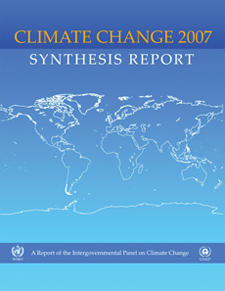Round Five, and IPCC
Rolls With the Punches
Rolls With the Punches
AS THE JUGGERNAUT of climate change outpaces predictions, the leading scientific body charged with taking measure of the risks associated with human-induced climate change will move into a new, solutions-based mode for its next round. Additionally, when the Intergovernmental Panel on Climate Change (IPCC) issues its Fifth Assessment Report in 2014 it will include for the first time both the complex carbon and biophysical impacts of land use change on the climate system thanks to Earth system modeling work from a team headed by George Hurtt of the Complex Systems Research Center.
The UNH effort is supported by a grant from the NASA Interdisciplinary Science Program entitled “Advancing our Understanding of the Earth System Through Coupled Carbon-Climate Modeling and
Observations.”
The “land use harmonization” modeling work Hurtt and colleagues have done smoothly combines historical land use data with future land use projections making it possible to include the effects of altered surface land cover into climate models. For example, changes in surface albedo or reflectivity and soil rooting depth – which affect energy balance and, in turn, further influences climate – will provide a much more comprehensive picture of climate change past, present, and future. The new data is a critical addition to the solutions-based approach.
Hurtt, along with co-authors Steve Frolking and Louise Chini of CSRC, published a paper on the land use harmonization work in the June issue of the Integrated Land Ecosystem-Atmosphere Processes Study or iLEAPS newsletter. iLEAPS is the land-atmosphere core project of the International Geosphere-Biosphere Programme or IGBP. (See http://ileaps.org.)
The Fifth Assessment Report will also differ from the previous four by taking what Hurtt calls a more “proactive, multidimensional” approach. That is, instead of simply making projections of different climate change scenarios in the future, this assessment will create “mitigation pathways to development” from which society can select the most practical, sustainable approaches to growth in the face of differing levels of potential climate change.
“This fifth round is forcing modelers to operate in a solution mode. The mitigation pathways are an attempt to find approaches to reduce the problem to different extents,” Hurtt says.
He notes that this next round will also be the first time the IPCC assessment will be built on the back of Earth system models rather than strictly climate models. This adds an entire new level of modeling complexity and potential clarity of what lies ahead.
Says Hurtt, “Uncertainty is paralyzing to a policy debate. The goal of science should be to reduce uncertainty and provide as accurate an assessment about the future as it can.” The fifth round of the IPCC is intended to be the clearest assessment yet. -DS
The UNH effort is supported by a grant from the NASA Interdisciplinary Science Program entitled “Advancing our Understanding of the Earth System Through Coupled Carbon-Climate Modeling and
IPCC Fourth Assessment Report
Image courtesy of IPCC |
The “land use harmonization” modeling work Hurtt and colleagues have done smoothly combines historical land use data with future land use projections making it possible to include the effects of altered surface land cover into climate models. For example, changes in surface albedo or reflectivity and soil rooting depth – which affect energy balance and, in turn, further influences climate – will provide a much more comprehensive picture of climate change past, present, and future. The new data is a critical addition to the solutions-based approach.
Hurtt, along with co-authors Steve Frolking and Louise Chini of CSRC, published a paper on the land use harmonization work in the June issue of the Integrated Land Ecosystem-Atmosphere Processes Study or iLEAPS newsletter. iLEAPS is the land-atmosphere core project of the International Geosphere-Biosphere Programme or IGBP. (See http://ileaps.org.)
The Fifth Assessment Report will also differ from the previous four by taking what Hurtt calls a more “proactive, multidimensional” approach. That is, instead of simply making projections of different climate change scenarios in the future, this assessment will create “mitigation pathways to development” from which society can select the most practical, sustainable approaches to growth in the face of differing levels of potential climate change.
“This fifth round is forcing modelers to operate in a solution mode. The mitigation pathways are an attempt to find approaches to reduce the problem to different extents,” Hurtt says.
He notes that this next round will also be the first time the IPCC assessment will be built on the back of Earth system models rather than strictly climate models. This adds an entire new level of modeling complexity and potential clarity of what lies ahead.
Says Hurtt, “Uncertainty is paralyzing to a policy debate. The goal of science should be to reduce uncertainty and provide as accurate an assessment about the future as it can.” The fifth round of the IPCC is intended to be the clearest assessment yet. -DS
by David Sims, Science Writer, Institute for the Study of Earth, Oceans, and Space. Published in Summer 2009 issue of EOS .

